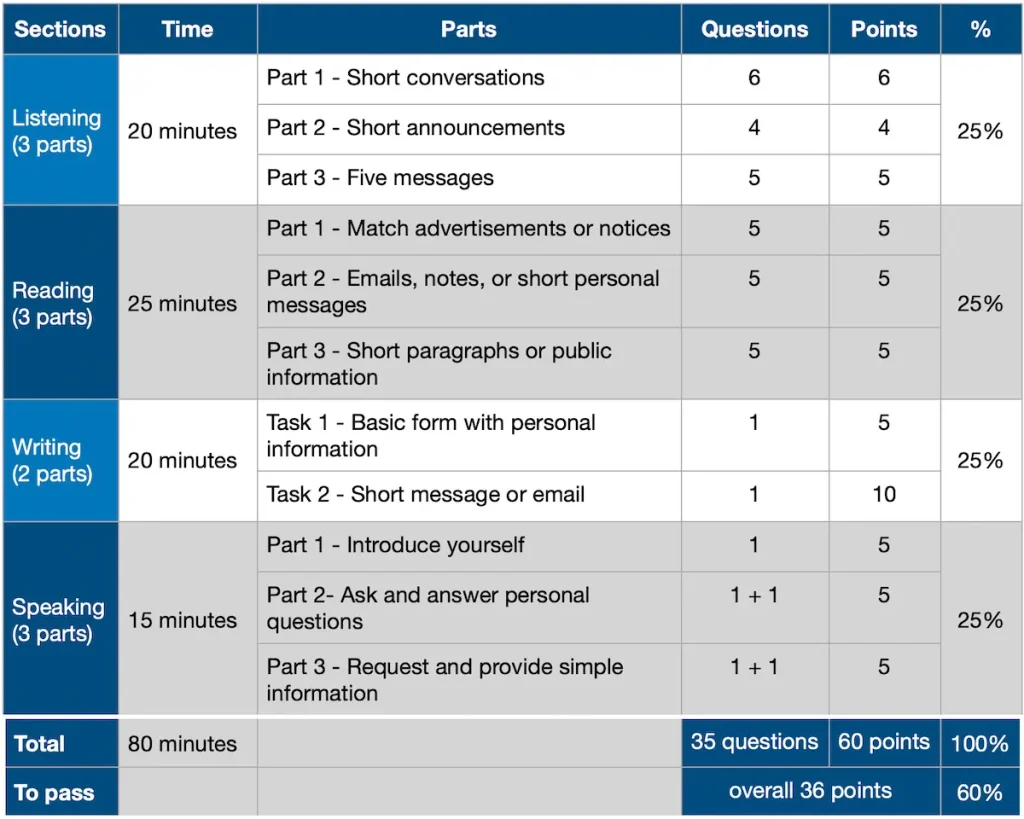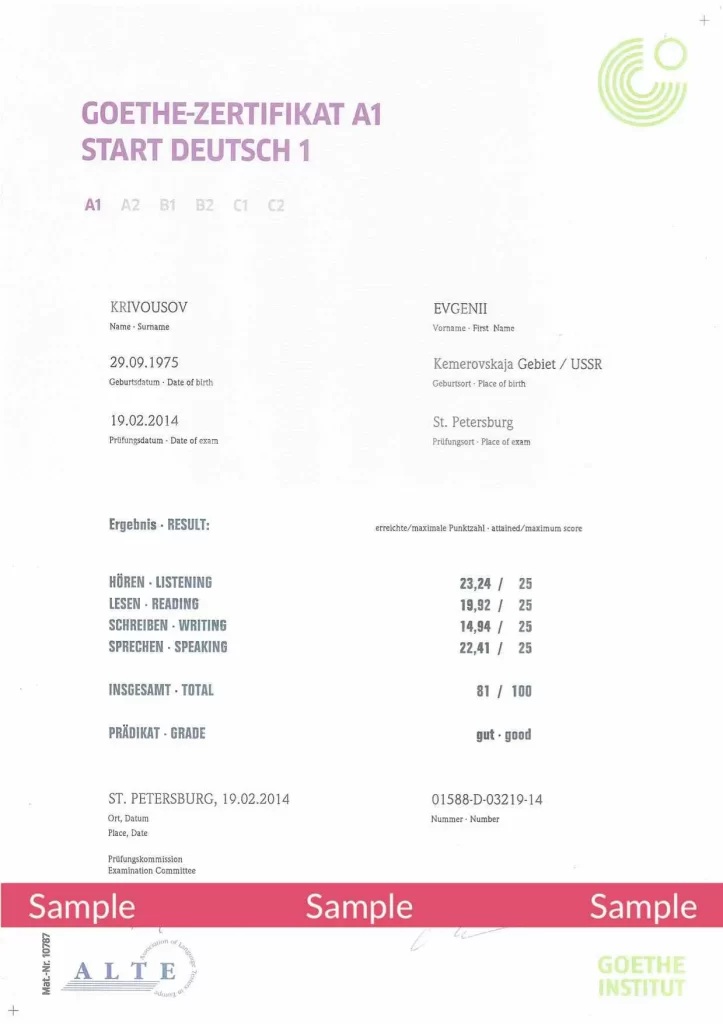The Goethe-Zertifikat A1: Start Deutsch is an internationally recognized certificate that proves you can handle basic German in real-life situations. It’s perfect for young students or professionals taking their first step toward life or work in Germany.
Understanding the Goethe A1 exam pattern helps you prepare smartly, focusing on simple conversations, writing messages, and following everyday instructions. This certificate isn’t just about language—it opens doors to visas, job interviews, and study programs.

Goethe A1 Exam Eligibility Criteria
The Goethe A1 exam pattern is designed to welcome absolute beginners, which makes its eligibility criteria broad and accessible. It doesn’t require fluency, formal training, or prior exposure to the language—just a willingness to learn and engage.
- Minimum Age Recommendation: While there’s no strict age limit, the exam is best suited for individuals aged 16 and above due to the structure and interaction level. Younger learners are encouraged to take youth-specific alternatives like Fit in Deutsch 1.
- No Academic Prerequisites: You don’t need any specific educational background. The exam suits both students and working professionals regardless of their academic history, focusing more on communication than academic performance.
- Open to Non-German Speakers: The “Goethe-Zertifikat A1: Start Deutsch” is tailored for those new to German.
- Globally Accepted: Whether you’re applying for a visa, job, or course in Germany, this exam is often the first requirement. It’s recognized by German institutions, employers, and embassies around the world.
Goethe A1 Exam Pattern – Detailed Structure
The Goethe A1 exam format is carefully structured to assess a learner’s ability to understand and use basic German in everyday situations. The test is divided into four core sections: Listening, Reading, Writing, and Speaking. Each section evaluates a specific language skill through realistic tasks.
Here’s a detailed overview including subsections, number of questions, and time limits:
Listening (Hören) – 20 minutes | 3 parts | 15 questions
Part 1: You’ll hear six short conversations played twice, each with three picture-based multiple-choice options. You must choose the image that matches what is heard.
Part 2: You’ll hear four short announcements played once. For each, determine whether a written statement is true or false based on the audio.
Most test takers find this part to be the most difficult. To correctly complete the task, you should pay attention to the numbers mentioned in the announcements.
Part 3: You’ll hear five messages played twice, each followed by a multiple-choice question without visual aids. This tests your ability to extract key details from basic audio content. Each message has a question with a choice of answers a, b or c.
Reading (Lesen) – 25 minutes | 3 parts | 15 questions
Part 1: Match five short texts (such as advertisements or notices) with corresponding questions or needs.
Part 2: Read emails, notes, or short personal messages and answer multiple-choice questions to show understanding of general content and detail. Each question is offered a choice of 2 ads, you need to mark the one that fits.
Part 3: Answer questions based on short paragraphs or public information texts (e.g., timetables, signs, schedules), identifying specific pieces of information.
Writing (Schreiben) – 20 minutes | 2 tasks
Task 1: Fill out a basic form with personal information like name, address, date of birth, and nationality.
Task 2: Write a short message or email (4–5 sentences) in response to a scenario—such as inviting a friend, cancelling an appointment, or asking for information. Clarity and relevance of content are important.
Speaking (Sprechen) – 15 minutes | 3 parts
Part 1: Introduce yourself with basic information—name, country, occupation, language spoken, etc. The is the easiest part of the test, as you can prepare a story about yourself in advance.
Part 2: Ask and answer personal questions with a partner. Topics include hobbies, living situations, and daily activities. There will be multiple cards, and each card has one word written on it, and the topic is indicated at the top. It is important to formulate questions in accordance with the given topic.
Part 3: Request and provide simple information using visual prompts like appointment cards or shopping lists. This section assesses your ability to hold short, polite interactions in everyday settings. It is assessed by cards, which depict various objects (for example, a glass of water, a lamp, a telephone, etc.).
Here are some must-know topics with examples for Goethe A1 sprechen.
All four sections together form a complete picture of your basic German communication skills. Equal scoring across sections ensures that every skill—whether you’re stronger in listening or writing—is given due weight.
After calculating the points, the number must be multiplied by a factor of 1.66 to see the total number of secondary points shown on the certificate.
Goethe A1 Passing Criteria
Many first-time learners often wonder, “Is Goethe A1 exam easy?” The answer depends on preparation, but the structure or the Goethe A1 exam pattern is certainly learner-friendly. The test is designed to assess your ability to use German in real-life situations, not to trick or overwhelm you with technical grammar. It rewards clarity, comprehension, and the ability to communicate basic ideas.
- Score Breakdown:
The Goethe A1 exam is scored out of 100 points, with each of the four sections—Listening, Reading, Writing, and Speaking—carrying 25 points. This equal distribution reflects the exam’s balanced focus on all language skills rather than favoring any one area. - Passing Requirement:
You must score at least 60 points overall to pass. This means you don’t need to excel in every section—consistent performance across the board is usually enough. For example, if you’re weaker in writing but confident in speaking and listening, those stronger areas can support your total score. - Evaluation Method:
Examiners follow a standardized rubric to ensure objective evaluation. In speaking, for instance, you’re assessed on fluency, pronunciation, and how well you respond to the given tasks—not on accent or advanced vocabulary. - Result Format:
Your result will be marked as “Passed” (Bestanden) or “Not Passed” (Nicht Bestanden). You also receive a detailed score sheet that shows how many points you earned in each section, helping you understand your strengths and areas for improvement. - No Sectional Cut-off:
There’s no requirement to pass each section individually. As long as your total score reaches 60, you pass—even if one section is slightly weaker. This aspect makes the answer to “Is Goethe A1 exam easy?” more encouraging, especially for first-time test-takers.
The Goethe A1 exam pattern supports new learners, offering a fair assessment without placing too much weight on perfection. With consistent preparation and a good understanding of practical German, achieving the required score is a realistic goal for most candidates.

Conclusion
The Goethe-Zertifikat A1: Start Deutsch is a beginner-friendly certification that opens the door to studying, working, or living in a German-speaking environment. The Goethe A1 exam pattern emphasizes communication over complexity, making it accessible even to first-time language learners.
With 80 to 120 hours of focused study, including practice in speaking, listening, and writing, most learners can prepare confidently. Alternatives like TELC A1 and ÖSD A1 are also valid options, depending on specific visa or institutional requirements.
If you’re planning to begin your German language journey, take the first step confidently—structured preparation makes all the difference. Start learning and make your goals in Germany a reality.